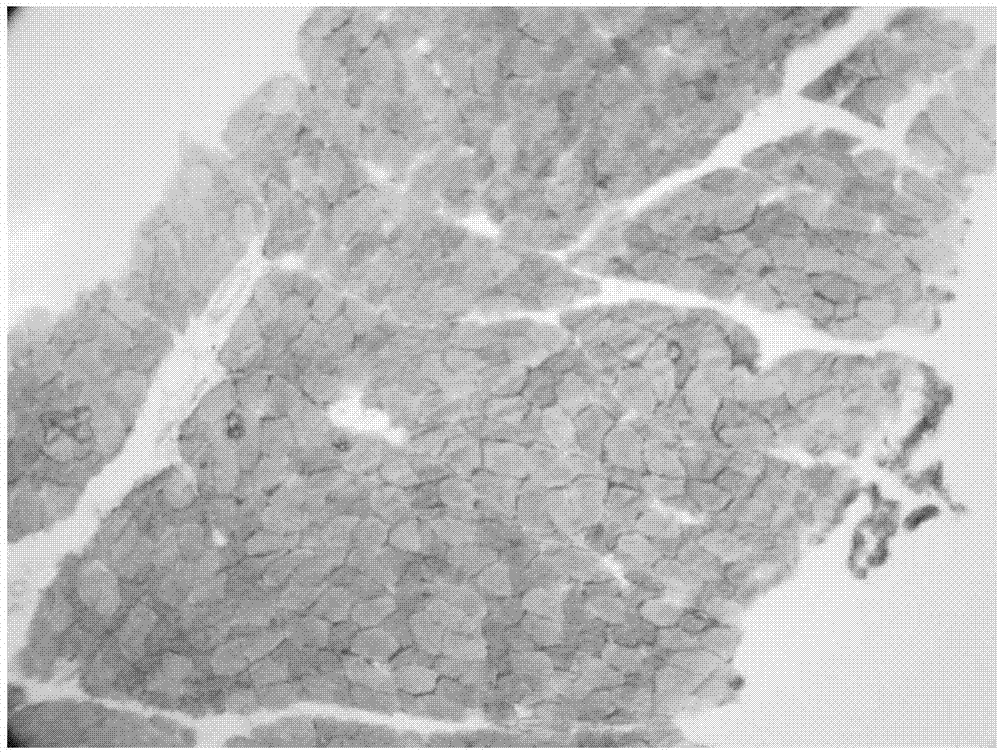Dyeing method for tissue glycogen
A dyeing method and technology of glycogen, applied in the biological field, can solve the problem of whether glycogen accumulates and where it accumulates, which cannot be easily and effectively preserved
- Summary
- Abstract
- Description
- Claims
- Application Information
AI Technical Summary
Problems solved by technology
Method used
Image
Examples
Embodiment 1
[0034] This embodiment provides a method for staining tissue glycogen, comprising the following steps:
[0035] (1) Section preparation: fix the freshly obtained target tissue with 2.5% (mass percent) neutral glutaraldehyde and 1.2% (mass percent) osmic acid, and then undergo routine procedures such as rinsing, dehydration, infiltration, resin embedding, and sectioning. The corresponding semi-thin slices were obtained through the transmission electron microscope section preparation process.
[0036] (2) Periodic acid oxidation: put the above-mentioned semi-thin slices on a 70°C roaster for 10 minutes, then add periodate solution (0.5-1.5% by mass) in a 38°C oven and place it for 13-20min (high Periodic acid can oxidize the polysaccharide ethylene glycol group in the cell into dialdehyde, and the periodate solution needs to be preheated, the preheating temperature is 38°C and the time is 12min); the temperature limited in this step can speed up the subsequent dyeing solution an...
Embodiment 2
[0043] This embodiment provides a method for staining tissue glycogen, comprising the following steps:
[0044] (1) Slice preparation: fix the freshly obtained target tissue with 2% neutral glutaraldehyde and 1.5% osmic acid, and then undergo conventional TEM slice preparation procedures such as rinsing, dehydration, infiltration, resin embedding, and sectioning to obtain Corresponding semi-thin slices.
[0045](2) Periodic acid oxidation: put the above semi-thin slices on a 70°C oven for 5 minutes, and then add periodic acid solution in a 35°C oven for 13 minutes (periodic acid can make the polysaccharide ethylene glycol in the cells base is oxidized to dialdehyde, and the periodate solution needs to be preheated. The preheating temperature is 35°C and the time is 10min); within 2 weeks to achieve the desired staining effect; periodate solution is a solution that is prepared within 2 weeks and stored in the refrigerator. When adding periodate solution, attention should be pa...
Embodiment 3
[0052] This embodiment provides a method for staining tissue glycogen, comprising the following steps:
[0053] (1) Slice preparation: fix the freshly obtained target tissue with 3% neutral glutaraldehyde and 1.0% osmic acid, and then undergo conventional TEM slice preparation procedures such as rinsing, dehydration, infiltration, resin embedding, and sectioning to obtain Corresponding semi-thin slices.
[0054] (2) Periodic acid oxidation: put the above semi-thin slices on a 75°C oven for 15 minutes, and then add periodic acid solution in a 40°C oven for 20 minutes (periodic acid can make the polysaccharide ethylene glycol in the cells base is oxidized to dialdehyde, the periodate solution needs to be preheated, the preheating temperature is 40°C, and the time is 15min); the temperature limited in this step can speed up the combination of the subsequent dye solution and the tissue, so that the dyeing can be done in a shorter time within 2 weeks to achieve the desired stainin...
PUM
 Login to View More
Login to View More Abstract
Description
Claims
Application Information
 Login to View More
Login to View More - R&D
- Intellectual Property
- Life Sciences
- Materials
- Tech Scout
- Unparalleled Data Quality
- Higher Quality Content
- 60% Fewer Hallucinations
Browse by: Latest US Patents, China's latest patents, Technical Efficacy Thesaurus, Application Domain, Technology Topic, Popular Technical Reports.
© 2025 PatSnap. All rights reserved.Legal|Privacy policy|Modern Slavery Act Transparency Statement|Sitemap|About US| Contact US: help@patsnap.com



